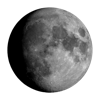Near Earth Object 137108
Near Earth Object 137108 is in the constellation of Gemini, at a distance of
Finder Charts
The sky charts below show, at different resolutions, the position of Near Earth Object 137108 in the sky. Click on each chart to access the interactive star map tool.
Equatorial Coordinates
Apparent
J2000
Additional Information
Rise and Set Times
The following table lists today's rise, transit and set times of Near Earth Object 137108 from Greenwich, UK (all times relative to the local timezone Europe/London):
If you need to access this information frequently for your observations, you can create a simple customized Quick Access page, so that you can easily bookmark it in your browser favorites or add a shortcut to your mobile phones' home screen.
Distance from Earth
The distance of Near Earth Object 137108 from Earth is currently
The following graph shows the distance of Near Earth Object 137108 from Earth as a function of time. In the chart the distance is measured in Astronomical Units and the data is sampled with an interval of 1 day.
Note: The values in this chart may not be entirely accurate around the time of closest approach for objects passing very close to Earth at high speed (e.g., Near-Earth Objects).
Closest Approach to Earth
During the next 10 years, the closest approach of Near Earth Object 137108 to Earth will happen on Saturday 7 August 2027 at a distance of 0.002606 Astronomical Units, or 389,855 kilometers:
Light Curve
The following chart shows the light curve of Near Earth Object 137108, i.e., its apparent magnitude as a function of time. The curve is calculated using the latest ephemerides provided by JPL Horizons. The magnitude data is sampled with the interval of 2 days. Because of this sampling, inaccuracies may occur for objects that have large variations of brightness over a few days. For comets, large discrepancies can arise between the calculated brightness and the observations due to their highly dynamic, and not always precisely predictable, behavior.
Orbital Elements
The following table lists the orbital elements of Near Earth Object 137108 at epoch March, 30 2024 00:00 UTC (JD: 2460400.5). Source: JPL Small-Body Database
| Element | Symbol | Value |
|---|---|---|
| Orbit eccentricity | e | 0.56223899 |
| Orbit inclination | i | 39.92859960° |
| Perihelion distance | q | 0.63849376 AU 95,517,307 km |
| Aphelion distance | Q |
2.27859456 AU 340,872,896 km |
| Semi-major axis | a |
1.45854416 AU 218,195,101 km |
| Orbital period | period |
1.7615 years 643.3952 days |
| Date of perihelion transit | Tp | December 5, 2023 2,460,284.1301 JD |
| Next perihelion transit | September 9, 2025 2,460,927.5253 JD |
|
| Argument of perihelion | peri | 268.32772474561° |
| Longitude of the ascending node | node | 314.34895072127° |
| Mean anomaly | M | 65.112637528428° |
| Mean motion | n | 0.55953170°/day |
Orbit Visualization
The following chart is a 3D animated visualization of the orbit of Near Earth Object 137108 relative to the other major objects in the Solar System. You can access more advanced features using our 3D Solar System Viewer.
15 Days Ephemeris
The following table lists the ephemerides of Near Earth Object 137108 computed for the past and next 7 days, with a 24 hours interval. Apparent celestial coordinates are provided.
| Date | Right AscensionR.A. | DeclinationDec. | MagnitudeMag | Constellation |
|---|---|---|---|---|
| Jun 29 2025 | 07h 29m 59s | +28° 15’ 17” | 20.80 | Gemini |
| Jun 30 2025 | 07h 32m 57s | +27° 52’ 52” | 20.77 | Gemini |
| Jul 01 2025 | 07h 35m 54s | +27° 30’ 05” | 20.74 | Gemini |
| Jul 02 2025 | 07h 38m 52s | +27° 06’ 54” | 20.71 | Gemini |
| Jul 03 2025 | 07h 41m 50s | +26° 43’ 22” | 20.68 | Gemini |
| Jul 04 2025 | 07h 44m 47s | +26° 19’ 26” | 20.64 | Gemini |
| Jul 05 2025 | 07h 47m 46s | +25° 55’ 07” | 20.61 | Gemini |
| Jul 06 2025 | 07h 50m 45s | +25° 30’ 24” | 20.58 | Gemini |
| Jul 07 2025 | 07h 53m 42s | +25° 05’ 19” | 20.54 | Gemini |
| Jul 08 2025 | 07h 56m 41s | +24° 39’ 48” | 20.51 | Gemini |
| Jul 09 2025 | 07h 59m 39s | +24° 13’ 52” | 20.47 | Gemini |
| Jul 10 2025 | 08h 02m 39s | +23° 47’ 32” | 20.44 | Cancer |
| Jul 11 2025 | 08h 05m 38s | +23° 20’ 46” | 20.40 | Cancer |
| Jul 12 2025 | 08h 08m 37s | +22° 53’ 36” | 20.37 | Cancer |
Additional Resources on TheSkyLive
- Near Earth Object 137108: Complete reference information on TheSkyLive.com.
- Where is Near Earth Object 137108?: Key information on where to find Near Earth Object 137108 in the sky.
- Distance of Near Earth Object 137108 from Earth: Find out how far Near Earth Object 137108 is from Earth right now.
- How Bright is Near Earth Object 137108?: Current visual brightness (magnitude) and apparent size.
- Rise and Set Times: Rise and set times of Near Earth Object 137108 from your location.
- Interactive Sky Map: Planetarium-style interactive visualization of Near Earth Object 137108's position in the sky.
- Ephemeris: 15 days Near Earth Object 137108's computed ephemeris.
- Orbital elements: Information about Near Earth Object 137108 orbital parameters.
- Orbit Visualization: 3D interactive visualization showing the orbit of Near Earth Object 137108 with respect to the major Solar System objects.










